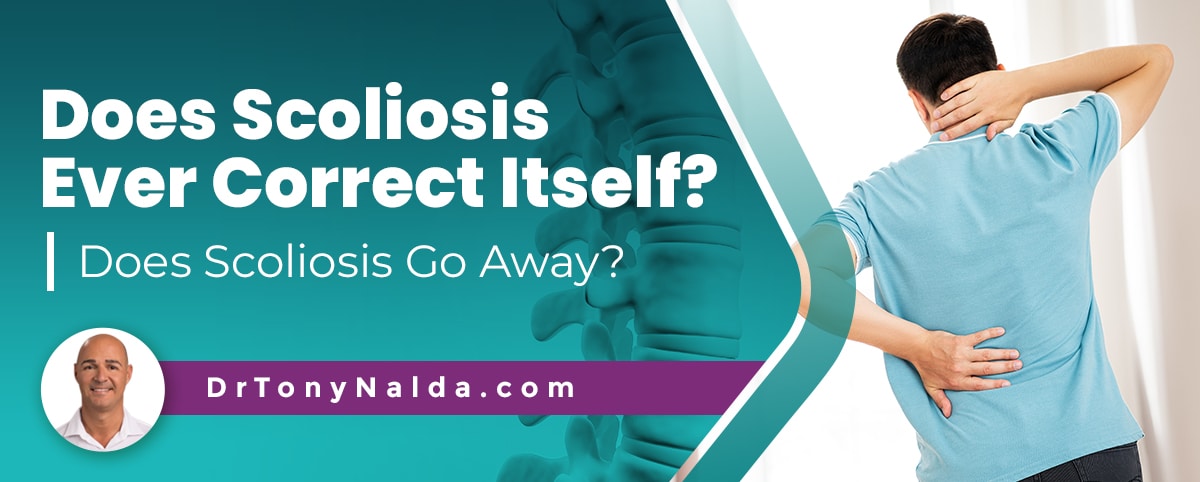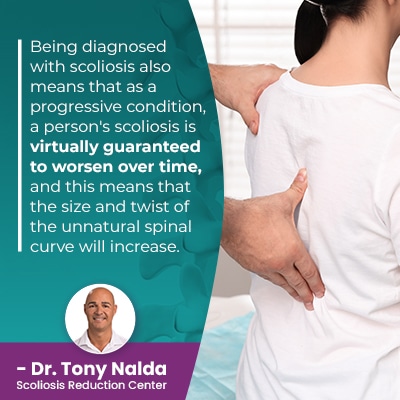Does Scoliosis Ever Correct Itself? Does Scoliosis Go Away?

When people ask if scoliosis can correct itself, many mean cure, and as a progressive structural spinal condition, there is no curing scoliosis; however, through conservative treatment, corrective results can be achieved, and this means reducing the curve on a structural level while increasing core strength so the spine receives optimal support from its surrounding muscles.
As a progressive condition, scoliosis is virtually guaranteed to worsen over time, but it is highly treatable, particularly if responded to with proactive treatment. As a structural condition, scoliosis can't correct itself without the help of active treatment that impacts it on a structural level.
To start our discussion on scoliosis treatment and correction, let's first explore what exactly it means to have scoliosis.
Table of Contents
Being Diagnosed with Scoliosis
Being diagnosed with scoliosis means that an unnatural spinal curve that bends to the side, and also rotates, has developed.
It's the rotational component that makes scoliosis a 3-dimensional condition, and in addition, an unnatural scoliotic curve has to be of a minimum size to be considered a true scoliosis: Cobb angle of at least 10 degrees.
A patient's Cobb angle is taken during X-ray and involves measuring how tilted the vertebrae at the curve's apex are, and this tells me how far out of alignment a scoliotic spine is, and classifies conditions based on severity:
- Mild scoliosis: Cobb angle measurement of between 10 and 25 degrees
- Moderate scoliosis: Cobb angle measurement of between 25 and 40 degrees
- Severe scoliosis: Cobb angle measurement of 40+ degrees
- Very-severe scoliosis: Cobb angle measurement of 80+ degrees
The higher the Cobb angle, the more severe the condition, and the more likely it is to cause noticeable symptoms.
Scoliosis is structural, meaning it's caused by an abnormality within the spine itself, so no change in position can reduce and/or remove the scoliotic curve, which is one reason it can't just go away on its own.
 Being diagnosed with scoliosis also means that as a progressive condition, a person's scoliosis is virtually guaranteed to worsen over time, and this means that the size and twist of the unnatural spinal curve will increase.
Being diagnosed with scoliosis also means that as a progressive condition, a person's scoliosis is virtually guaranteed to worsen over time, and this means that the size and twist of the unnatural spinal curve will increase.
As scoliosis introduces a lot of uneven forces to the body, progression means those uneven forces are also increasing, which can affect the body in a number of ways.
In addition to the wide range of severity, there are also different types of scoliosis a person can develop, so let's take a minute to discuss the various condition types.
Different Types of Scoliosis
In addition to a scoliosis diagnosis involving a classification based on severity, condition type is also a key factor as different forms of scoliosis can have unique symptoms and treatment needs.
The most common type of scoliosis is idiopathic, and this is the most common form to affect children and adults.
Idiopathic Scoliosis
Idiopathic means not clearly associated with a single-known cause, meaning we don't fully understand its etiology, and while this can sound discouraging to those recently diagnosed with idiopathic scoliosis, I point out that knowing why a condition developed doesn't necessarily change the course of treatment, or its outcome; what's most important is how a diagnosis is responded to.
The most prevalent form of scoliosis is adolescent idiopathic scoliosis (AIS), diagnosed between the ages of 10 and 18, so for our current purposes, this is the type we'll focus on.
Approximately 80 percent of known diagnosed scoliosis cases are idiopathic, and the remaining 20 percent are associated with known causes.
Scoliosis with Known Causes
Scoliosis types that are associated with known causes include neuromuscular scoliosis, degenerative scoliosis, and congenital scoliosis.
Neuromuscular scoliosis patients have a neuromuscular condition such as cerebral palsy, muscular dystrophy, or spina bifida, to name a few, that has caused the scoliosis to develop as a secondary complication.
Degenerative scoliosis patients are often over the age of 40 as this type is caused by natural age-related spinal degeneration that impacts the spine's ability to maintain its natural curve and alignment.
Congenital scoliosis patients are born with the condition as it's caused by a malformation within the spine that develops in utero.
In these types of cases, when a condition's causation is understood, the underlying cause shapes the crafting of effective treatment plans.
So for those recently diagnosed, what types of symptoms can be expected to develop over time?
Scoliosis Symptoms
While no two cases of scoliosis are the same, which is why treatment plans need to be customized to address key patient/condition variables, there are some common symptoms.
As scoliosis introduces a lot of uneven forces to the body, its effects can be widespread and not just isolated to the back, especially once the condition becomes compressive in adulthood.
The condition's most-common symptoms include postural changes and pain.
Postural Deviation
While we don't always know what causes scoliosis to develop, we do understand what causes it to progress: growth and development.
So particularly in adolescent idiopathic scoliosis, we know these patients are at risk for rapid-phase progression because of the stage of puberty characterized by rapid and unpredictable growth spurts.
This is another reason the condition won't go away on its own; in young patients who are still growing, the constant trigger of growth is occurring.
In children and adolescents, the main scoliosis symptoms involve changes to posture such as:
- Uneven shoulders
- Uneven shoulder blades
- The development of a rib arch
- Uneven waistline
- Uneven hips
- Arms and legs that appear to hang at different lengths
These changes are the result of the condition's uneven forces disrupting the body's overall symmetry, and in addition, changes to gait, balance, and coordination are additional condition indicators.
When it comes to pain, children and adolescents experience pain very differently from adults, and this is due to compression.
Scoliosis Pain
When it comes to back pain, scoliosis isn't generally described as painful for young patients who have yet to reach skeletal maturity; this is because scoliosis doesn't become compressive until adulthood, once growth has stopped.
Growing spines are experiencing a constant lengthening motion that counteracts the compressive force of the unnatural spinal curve, and it's compression of the spine and its surrounding muscles and nerves that causes the majority of condition-related pain.
So although adolescents can experience muscle pain caused by muscles straining to support unnatural scoliosis curves, and related muscle imbalance, back pain is most often a symptom caused by adult scoliosis curves.
In fact, when it comes to adult scoliosis, pain is the number-one symptom that brings them in for a diagnosis and treatment.
Due to nerve compression, radiating pain is also an issue, and as nerves are like branches on a tree, fanning off in multiple directions, radicular pain can be felt far from its site of origin; radicular scoliosis pain is often felt in the extremities.
So particularly in adult scoliosis, once the degenerative effects of aging are experienced by the spine, progressive rates can increase as the spine is weaker and less able to maintain its natural curves and alignment, not to mention that many people experience muscle loss as they age, meaning the core muscles are less able to support the spine.
So if a scoliosis curve won't correct itself, what can correct it?
Scoliosis Correction and Proactive Treatment
When it comes to treating scoliosis, there are two main treatment approaches to choose between: traditional and conservative.
 Traditional treatment commonly funnels patients towards spinal fusion surgical intervention, which can adversely affect the spine's overall health, flexibility, and function.
Traditional treatment commonly funnels patients towards spinal fusion surgical intervention, which can adversely affect the spine's overall health, flexibility, and function.
Through a conservative treatment approach, however, corrective results can be achieved by integrating multiple treatment disciplines such as chiropractic adjustments, physical therapy, corrective bracing, and custom-prescribed home exercises.
If left untreated, scoliosis is virtually guaranteed to progress, at varying rates; only proactive treatment can work towards counteracting the condition's progressive nature.
Non surgical methods can preserve as much of the spine's natural function and flexibility as possible and strive to improve scoliosis through impacting it, first and foremost, on a structural level.
Here at the Scoliosis Reduction Center, I apply condition-specific chiropractic care to work towards repositioning the most-tilted vertebrae, at the curve's apex, back into alignment with the rest of the spine.
Through physical therapy, I can help patients increase core strength so the spine can be optimally supported by its surrounding muscles, while addressing areas of muscle imbalance.
Through the prescription of a corrective back brace, like the ScoliBrace, corrective results can be augmented by pushing the spine into a corrective position.
A series of custom-prescribed exercises can help patients establish a home-rehabilitation program to further stabilize the spine.
So correcting a scoliosis doesn't mean it's cured, in the way that most people understand the word cure, but rather, corrective results have been achieved, but efforts will have to continue to hold the spine where it is and sustain those results.
Conclusion
As a structural, and progressive, spinal condition, scoliosis can't simply go away on its own; active treatment has to be applied that works towards counteracting its progressive nature.
Treatment options include both surgical intervention and non surgical methods, and here at the Center, I believe in a nonsurgical conservative treatment approach that combines chiropractic care, physical therapy, corrective bracing, and rehabilitation to restore as much of the spine's healthy curves as possible, increase core strength, and further stabilize the spine.
By being proactive with treatment, the vast majority of scoliosis cases don't require surgery, but if left untreated, a scoliosis curve can become worse (progress), and severe cases are more likely to require surgical intervention.
The truth is that while scoliosis is incurable, it is highly treatable, and patients that commit to a proactive conservative treatment approach can go on to not only living normal lives, but thriving, despite having a progressive spinal condition.
Dr. Tony Nalda
DOCTOR OF CHIROPRACTIC
After receiving an undergraduate degree in psychology and his Doctorate of Chiropractic from Life University, Dr. Nalda settled in Celebration, Florida and proceeded to build one of Central Florida’s most successful chiropractic clinics.
His experience with patients suffering from scoliosis, and the confusion and frustration they faced, led him to seek a specialty in scoliosis care. In 2006 he completed his Intensive Care Certification from CLEAR Institute, a leading scoliosis educational and certification center.
About Dr. Tony Nalda
 Ready to explore scoliosis treatment? Contact Us Now
Ready to explore scoliosis treatment? Contact Us Now





